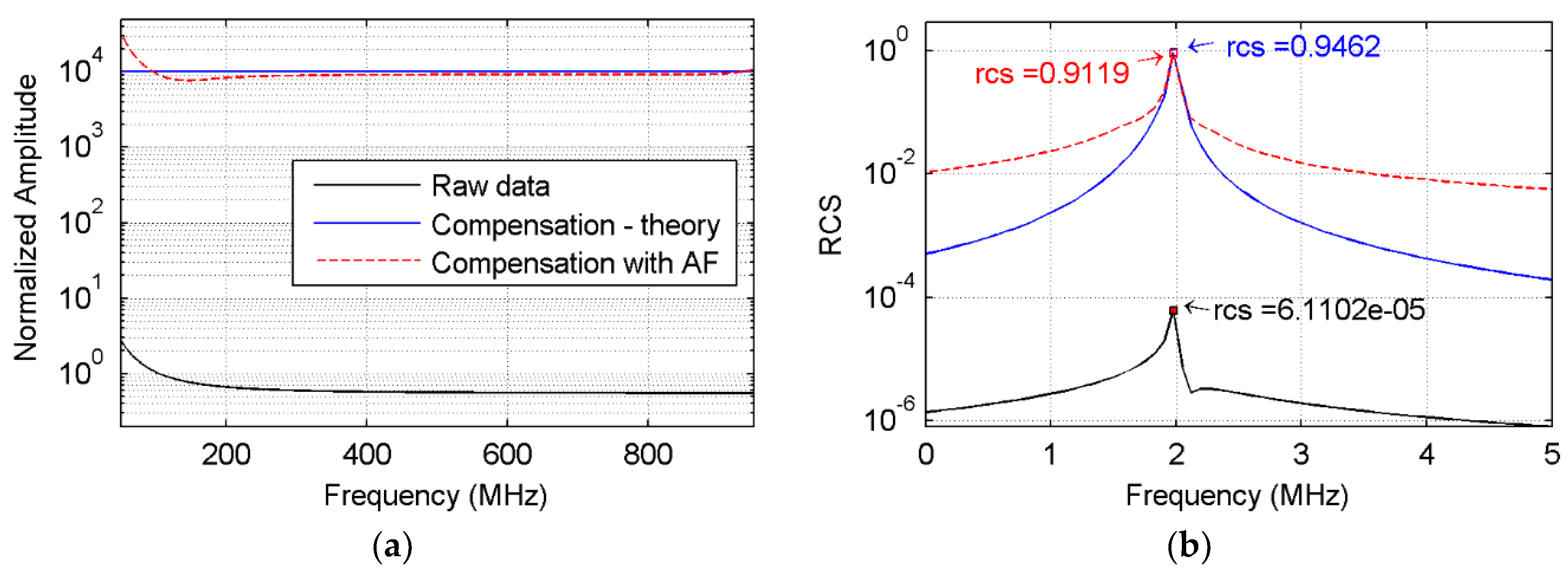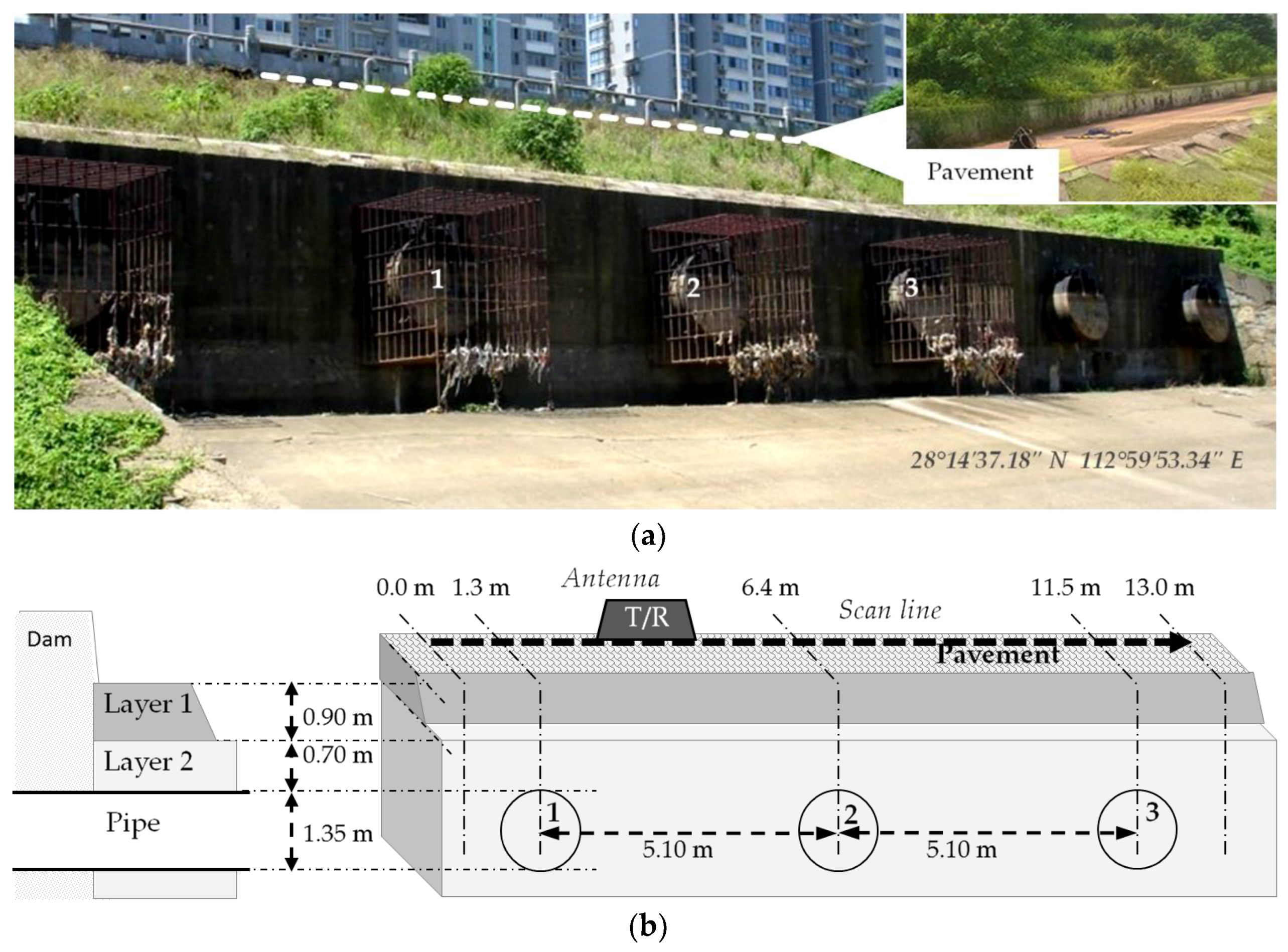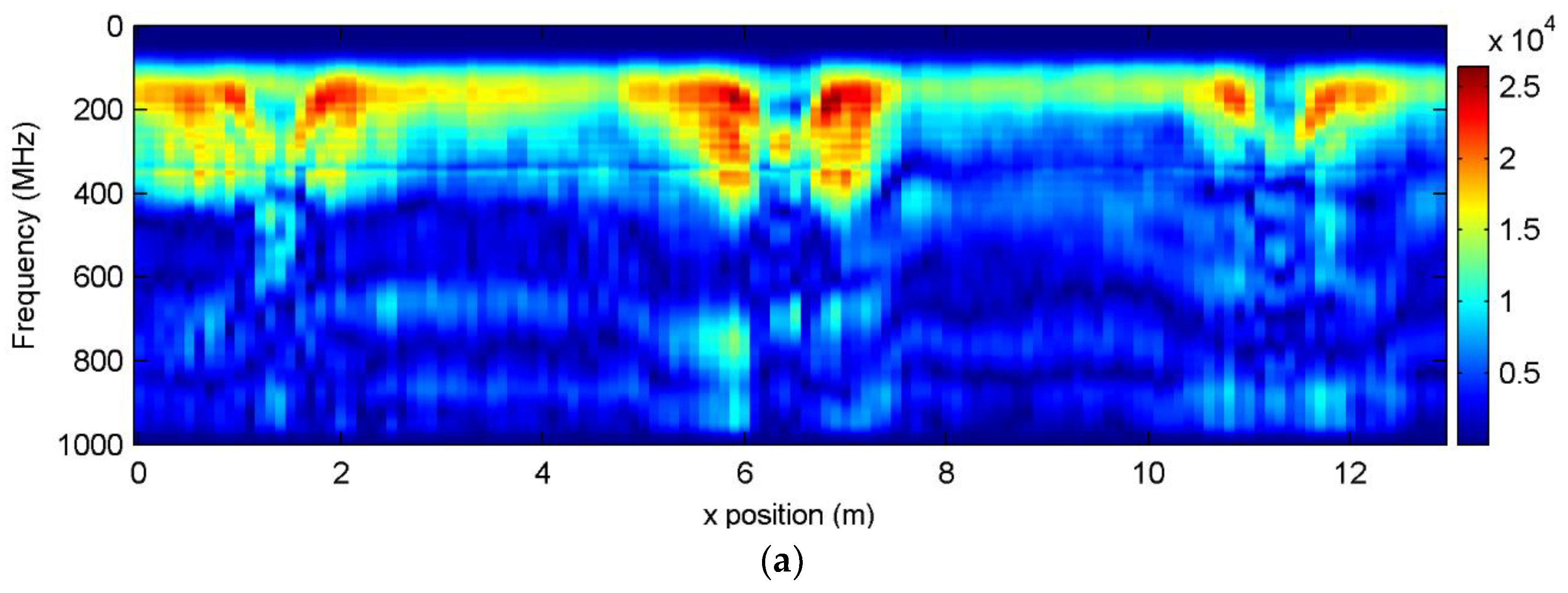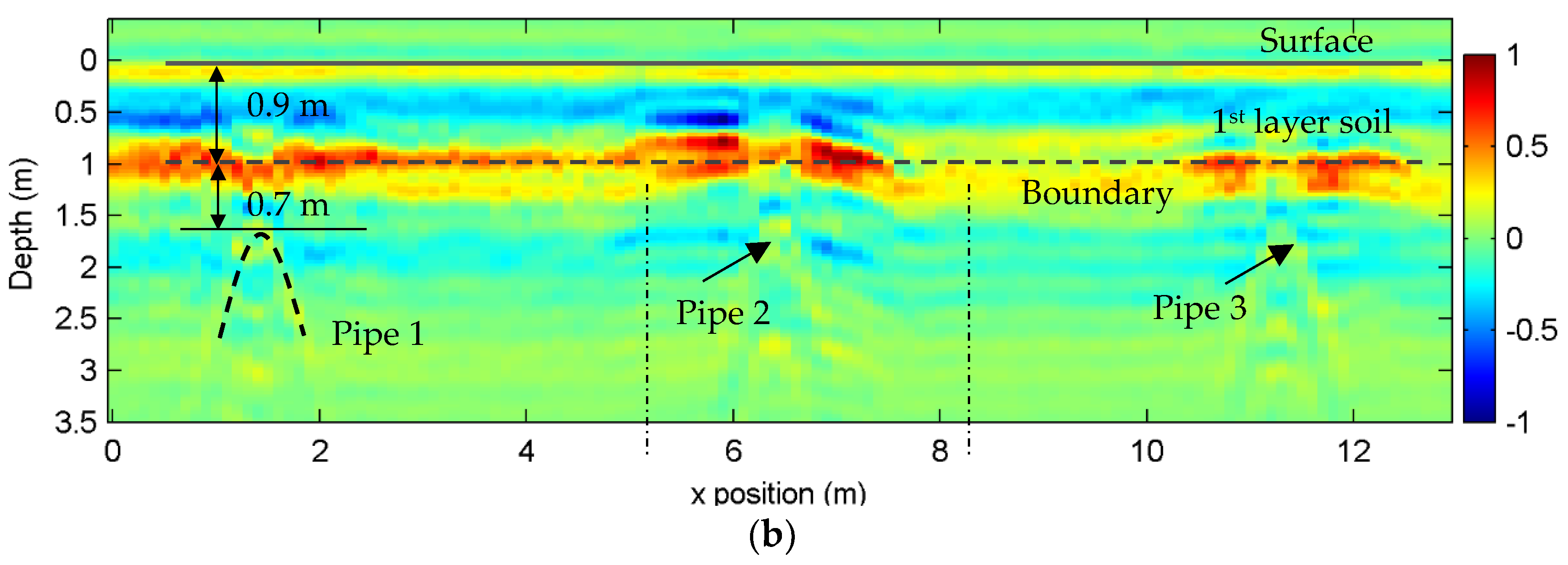Method for Compensating Signal Attenuation Using Stepped-Frequency Ground Penetrating Radar
Abstract
:1. Introduction
2. SFCW GPR Modulation
3. Attenuation Compensation
3.1. Signal Attenuation Mode of SFCW GPR
3.2. Attenuation Compensation—Theory
3.3. Attenuation Compensation for the Real Scenario
4. Experimental Results
5. Discussion and Conclusions
Author Contributions
Funding
Conflicts of Interest
References
- Koppenjan, S. Ground Penetrating Radar Systems and Design. In Ground Penetrating Radar Theory and Applications; Jol, H.M., Ed.; Elsevier: Amsterdam, The Netherlands, 2009. [Google Scholar]
- Kong, F.N.; By, T.L. Performance of a GPR system which uses step frequency signals. J. Appl. Geophys. 1995, 33, 15–26. [Google Scholar] [CrossRef]
- Sugak, V.G.; Sugak, A.V. Phase Spectrum of Signals in Ground-Penetrating Radar Applications. IEEE Trans. Geosci. Remote Sens. 2010, 48, 1760–1767. [Google Scholar] [CrossRef]
- Alberti, G.; Ciofaniello, L.; Noce, M.D.; Esposito, S. A stepped frequency GPR system for underground prospecting Giovanni Galiero, Raffaele Persico, Marco Sacchettino and Sergio Vetrella. Ann. Geophys. 2002, 45, 375–392. [Google Scholar]
- Koppenjan, S.K.; Allen, C.M.; Gardner, D.; Wong, H.R.; Hua, L.; Lockwood, S.J. Multi-frequency synthetic-aperture imaging with a lightweight ground penetrating radar system. J. Appl. Geophys. 2000, 43, 251–258. [Google Scholar] [CrossRef]
- Park, J.; Nguyen, C. Development of a new millimeter-wave integrated-circuit sensor for surface and subsurface sensing. IEEE Sens. J. 2006, 6, 650–655. [Google Scholar] [CrossRef]
- Sai, B.; Ligthart, L.P. GPR Phase-Based Techniques for Profiling Rough Surfaces and Detecting Small, Low-Contrast Landmines Under Flat Ground. IEEE Trans. Geosci. Remote Sens. 2004, 42, 318–326. [Google Scholar] [CrossRef]
- Counts, T.; Gurbuz, A.C.; Scott, W.R.; Mcclellan, J.H.; Kim, K. Multistatic Ground-Penetrating Radar Experiments. IEEE Trans. Geosci. Remote Sens. 2007, 45, 2544–2553. [Google Scholar] [CrossRef]
- Persico, R.; Prisco, G. A Reconfigurative Approach for SF-GPR Prospecting. IEEE Trans. Antennas Propag. 2008, 56, 2673–2680. [Google Scholar] [CrossRef]
- Duggal, S.; Sinha, P.; Gupta, M.; Patel, A.; Vedam, V.V.; Mevada, P.; Chavda, R.; Shah, A.; Putrevu, D. Design of a low cost miniaturized SFCW GPR with initial results. In Proceedings of the 2016 SPIE Asia-Pacific Remote Sensing, New Delhi, India, 4–7 April 2016. [Google Scholar]
- Langman, A. The Design of Hardware and Signal Processing for a Stepped Frequency Continuous Wave Ground Penetrating Radar; University of Cape Town: Cape Town, South Africa, 2002. [Google Scholar]
- Perroud, H.; Tygel, M. Velocity estimation by the common-reflection-surface (CRS) method: Using ground-penetrating radar data. Geophysics 2005, 70, B43–B52. [Google Scholar] [CrossRef]
- Streich, R.; Jan, V.D.K.; Green, A.G. Vector-migration of standard copolarized 3D GPR data. Geophysics 2007, 72, J65–J75. [Google Scholar] [CrossRef]
- Nicolaescu, I. Improvement of Stepped-Frequency Continuous Wave Ground-Penetrating Radar Cross-Range Resolution. IEEE Trans. Geosci. Remote Sens. 2013, 51, 85–92. [Google Scholar] [CrossRef]
- Gurbuz, A.C.; McClellan, J.H.; Scott, W.R. A Compressive Sensing Data Acquisition and Imaging Method for Stepped Frequency GPRs. IEEE Trans. Signal Process. 2009, 57, 2640–2650. [Google Scholar] [CrossRef]
- Qi, F.; Liang, F.; Lv, H.; Li, C.; Chen, F.; Wang, J. Detection and Classification of Finer-Grained Human Activities Based on Stepped-Frequency Continuous-Wave Through-Wall Radar. Sensors 2016, 16, 885. [Google Scholar] [CrossRef] [PubMed]
- Pieraccini, M.; Tarchi, D.; Rudolf, H.; Leva, D.; Luzi, G.; Bartoli, G.; Atzeni, C. Structural static testing by interferometric synthetic radar. NDTE Int. 2000, 33, 565–570. [Google Scholar] [CrossRef]
- Sohsalam, P.; Sirianuntapiboon, S. Feasibility of using constructed wetland treatment for molasses wastewater treatment. Bioresour. Technol. 2008, 99, 5610–5616. [Google Scholar] [CrossRef] [PubMed]
- Owerko, T.; Ortyl, L.; Kocierz, R.; Kuras, P.; Salamak, M. Investigation of displacements of road bridges under test loads using radar interferometry—Case study, Bridge Maintenance, Safety, Management, Resilience and Sustainability. In Proceedings of the Sixth International IABMAS Conference, Stresa, Lake Maggiore, Italy, 8–12 July 2012; pp. 181–188. [Google Scholar]
- Qu, L.; Yang, T. Investigation of Air/Ground Reflection and Antenna Beamwidth for Compressive Sensing SFCW GPR Migration Imaging. IEEE Trans. Geosci. Remote Sens. 2012, 50, 3143–3149. [Google Scholar] [CrossRef]
- Hartikainen, A.; Pellinen, T.; Huuskonen-Snicker, E.; Eskelinen, P. Algorithm to process the stepped frequency radar signal for a thin road surface application. Constr. Build. Mater. 2018, 158, 1090–1098. [Google Scholar] [CrossRef]
- Nouioua, I.; Rouabhia, A.; Fehdi, C.; Boukelloul, M.L.; Gadri, L.; Chabou, D.; Mouici, R. The application of GPR and electrical resistivity tomography as useful tools in detection of sinkholes in the Cheria Basin (northeast of Algeria). Environ. Earth Sci. 2013, 68, 1661–1672. [Google Scholar] [CrossRef]
- Gómez-Ortiz, D.; Martín-Crespo, T. Assessing the risk of subsidence of a sinkhole collapse using ground penetrating radar and electrical resistivity tomography. Eng. Geol. 2012, 149–150, 1–12. [Google Scholar] [CrossRef]
- Delle Rose, M.; Leucci, G. Towards an integrated approach for characterization of sinkhole hazards in urban environments: The unstable coastal site of Casalabate, Lecce, Italy. J. Geophys. Eng. 2010, 7, 143. [Google Scholar] [CrossRef]
- Pavlič, M.U.; Praznik, B. Detecting karstic zones during highway construction using ground-penetrating radar. Acta Geotech. Slov. 2011, 8, 17–27. [Google Scholar]
- Prinzio, M.D.; Bittelli, M.; Castellarin, A.; Pisa, P.R. Application of GPR to the monitoring of river embankments. J. Appl. Geophys. 2010, 71, 53–61. [Google Scholar] [CrossRef]
- Su, Y.; Huang, C.; Lei, W. Ground Penetrating Radar—Theory and Applications; Science Press: Beijing, China, 2006; ISBN 7-03-017283-3. [Google Scholar]
- Daniels, D.J. Ground Penetrating Radar; John Wiley & Sons, Inc.: Hoboken, NJ, USA, 2005. [Google Scholar]
- Wang, H.; Lu, B.; Zhou, Z. Design of a Ultra-wide Band Low Switching Time Stepped-frequency Signal Generator. Mod. Radar 2010, 2010, 83–86. [Google Scholar]
- Borgioli, G.; Capineri, L.; Falorni, P.; Matucci, S.; Windsor, C.G. The Detection of Buried Pipes from Time-of-Flight Radar Data. IEEE Trans. Geosci. Remote Sens. 2008, 46, 2254–2266. [Google Scholar] [CrossRef]
- Rial, F.; Lorenzo, H.; Pereira, M.; Armesto, J. Waveform Analysis of UWB GPR Antennas. Sensors 2009, 9, 1454–1470. [Google Scholar] [CrossRef] [PubMed]
- Daniels, D.J. Surface-penetrating radar. Electron. Commun. Eng. J. 1996, 8, 165–182. [Google Scholar] [CrossRef]
- Choi, H.I.; Williams, W.J. Improved time-frequency representation of multicomponent signals using exponential kernels. IEEE Trans. Acoust. Speech Signal Process. 2002, 37, 862–871. [Google Scholar] [CrossRef]
- Martorella, M.; Acito, N.; Berizzi, F. Statistical CLEAN Technique for ISAR Imaging. IEEE Trans. Geosci. Remote Sens. 2007, 45, 3552–3560. [Google Scholar] [CrossRef]
- Zhu, S.P.; Huang, C.L.; Min, L.U. Software Design of Real-time Pre-processor of Stepped-Frequency Ground Penetrating Radar. Microprocessors 2009, 6, 69–73. [Google Scholar]
- Lei, W.T.; Su, Y.; Liu, L. TAM-BP Imaging Algorithm of Objects Embedded in Planar Layer Media. Signal Process. 2007, 5, 680–685. [Google Scholar]









© 2018 by the authors. Licensee MDPI, Basel, Switzerland. This article is an open access article distributed under the terms and conditions of the Creative Commons Attribution (CC BY) license (http://creativecommons.org/licenses/by/4.0/).
Share and Cite
Liu, T.; Zhu, Y.; Su, Y. Method for Compensating Signal Attenuation Using Stepped-Frequency Ground Penetrating Radar. Sensors 2018, 18, 1366. https://doi.org/10.3390/s18051366
Liu T, Zhu Y, Su Y. Method for Compensating Signal Attenuation Using Stepped-Frequency Ground Penetrating Radar. Sensors. 2018; 18(5):1366. https://doi.org/10.3390/s18051366
Chicago/Turabian StyleLiu, Tao, Yutao Zhu, and Yi Su. 2018. "Method for Compensating Signal Attenuation Using Stepped-Frequency Ground Penetrating Radar" Sensors 18, no. 5: 1366. https://doi.org/10.3390/s18051366
APA StyleLiu, T., Zhu, Y., & Su, Y. (2018). Method for Compensating Signal Attenuation Using Stepped-Frequency Ground Penetrating Radar. Sensors, 18(5), 1366. https://doi.org/10.3390/s18051366




